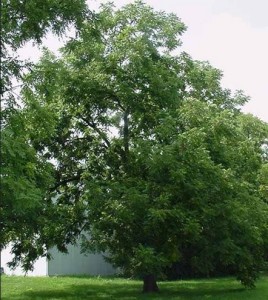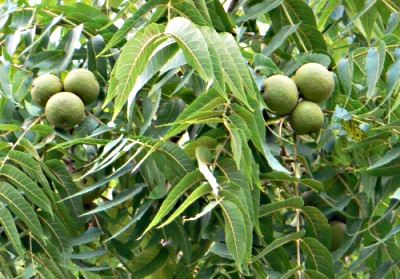Black Walnut – Juglans nigra
|
Current Demand = Normal |
Parts Used: Leaves and Hulls |
Family: Juglandaceae
Common Names: jupiter’s nut, american walnut, eastern black walnut, greek nut, carya…
Growing Region
The Black Walnut is native to eastern North America its primary native region is the Midwest and east-central United State. It grows mostly in riparian zones, from southern Ontario, west to southeast South Dakota, south to Georgia, northern Florida and southwest to central Texas. Wild trees in the upper Ottawa Valley may be an isolated native population or may have derived from planted trees.
Description and Growing
The black walnut is a large deciduous tree attaining heights of 30–40 m (98–131 ft). Under forest competition, it develops a tall, clear trunk; the open-grown form has a short trunk and broad crown. The bark is grey-black and deeply furrowed. The pith of the twigs contains air spaces. The leaves are alternate, 30–60 cm long, odd-pinnate with 15–23 leaflets, with the largest leaflets located in the center, 7–10 cm long and 2–3 cm broad. The male flowers are in drooping catkins 8–10 cm long, the female flowers are terminal, in clusters of two to five, ripening during the autumn into a fruit (nut) with a brownish-green, semifleshy husk and a brown, corrugated nut. The whole fruit, including the husk, falls in October; the seed is relatively small and very hard. The tree tends to crop more heavily in alternate years. Fruiting may begin when the tree is 4–6 years old, however large crops take 20 years. Total lifespan of J. nigra is about 130 years. Black Walnut does not leaf out until late spring when the soil has warmed and all frost danger is past. Like other trees of the Fagales order (oaks, hickories, chestnuts, birches, etc.), it has monoecious wind-pollinated catkins. The flowers comprise separate males and females, which do not appear on the same plant at once in order to prevent self-pollination and inbreeding. Thus, two trees are required to produce a seed crop and Black Walnut readily hybridizes with other members of the Juglans genus.
It will grow in closed forests, but needs full sun for optimal growth and nut production. Because of this, black walnut is a common weed tree found along roadsides, fields, and forest edges in the eastern US.
Harvesting/Drying:
Parts used: leaves and hulls
For maximum potency Black Walnut leaves should be harvested in the mid to late summer months while the plant is in bloom. When gathering Black Walnut leaves, only harvest the leaves. For drying purposes and to preserve the green color gather in the afternoon once the morning dew has dried.
After harvest, remove all foreign matter (rocks, weeds and pine needles) and spread in a thin layer immediately. Black Walnut leaves can be dried outdoors though it needs to be dried out of the sun. At night cover your leaves to keep the dew from setting on the drying herb. When possible dry indoors in a well ventilated barn loft or attic to protect from the elements. If natural heat is not available you may need to add heat and a fan for continuous airflow. Hanging lightly filled mesh bags from the rafters works well for drying Black Walnut leaves. Whether you dry indoors or outdoors you will need to turn or stir the leaf daily.
The key to drying any root, herb or bark is an even combination of heat and airflow. Never dry in an oven or microwave.
The Black Walnut leaves will be completely dry (largest stem will snap not bend) in 3-7 days depending on the drying conditions. Once it is dried place the leaves carefully into a cardboard box or paper bag for storage in a dry area until you are ready to sell or use. Never store Deer Tongue in plastic or it will mold.
Images Attribution: Wikipedia.org
 Root Buyer
Root Buyer
